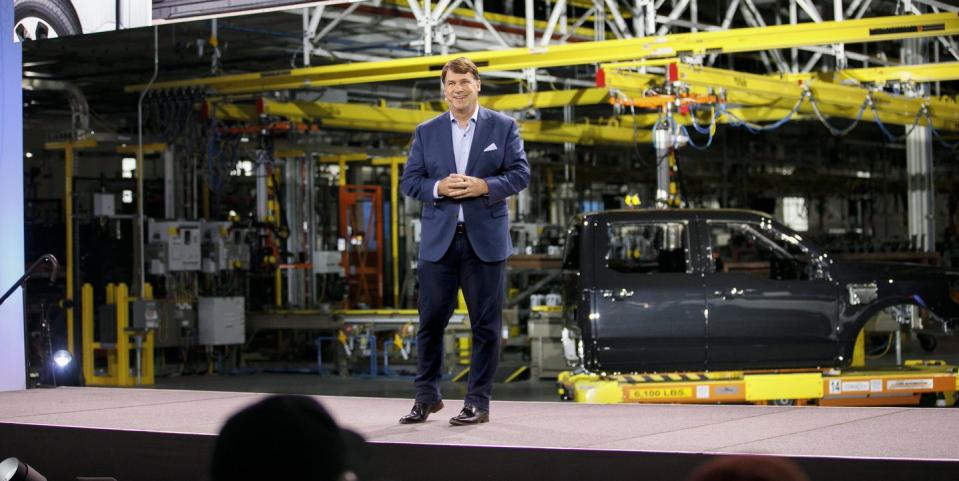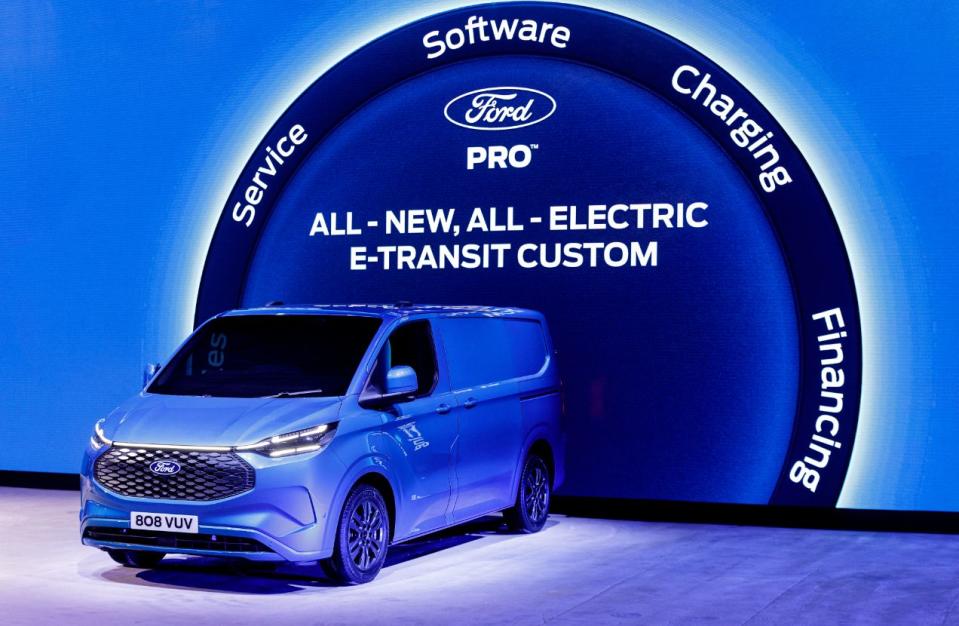How Red Bull Aerodynamics Can Extend Range for Next Ford Lightning

Ford executives outlined to auto analysts on Wednesday how the Blue Oval’s latest “Ford+” reorganization will eventually earn 8% profit margin on battery-electric vehicles.
CEO Jim Farley (pictured above at last year’s F-150 Lightning launch) says Ford has an “opportunity” to throw out old prejudices in designing and engineering its next EVs.
“Did I think we’d be No.1 in (EV) pickup trucks? No. I thought there’d be three” competitors in the pickup segment last year, Farley says.
Throwing out 120 years of internal-combustion development “prejudices,” Ford Motor Co. can engineer an extra 75 miles of EV range in next-generation F-150 Lightning pickup trucks from better aerodynamics alone, CEO Jim Farley says. This requires the best aerodynamic engineers in the auto industry, as well as the best auto engineers in the world, CFO John Lawler adds.
“Why do you think we’re doing Formula 1?” Farley says. “Because they have the best aero people in the world.”
Can hardly wait for the Lightning Red Bull edition.
Farley and Lawler outlined to auto analysts and Wall Street how the Blue Oval’s latest “Ford+” reorganization will go from “leaving $2 billion in profits” in 2022 to eventually earning 8% profit margin on battery-electric vehicles, in their “fireside chat” at the Wolfe Global Auto, Auto Tech and Auto Consumer Conference in New York City, moderated Wednesday by Wolfe Research Director Rod Lache.
More than half of Ford’s leadership team is new to the automaker, Farley says. Ford has an “opportunity” to throw out old prejudices not only in designing and engineering its next EVs, but also for its traditional combustion-powered vehicles.
Last March, Ford split into three distinct business units: Model-e (the name Elon Musk tried to snag years ago for what became the Telsa Model 3); Blue, the gas-powered “legacy” models; and its Pro commercial-vehicle business, which claims more than 50% of the segment and is quickly adding EVs to its portfolio.
Ford’s presentation at Wolfe Global Auto included a display of how large castings could replace many smaller parts more common in ICE architectures. At least, that’s what we could glean from live audio provided by Ford—Wolfe Research does not invite media to its events.
The wiring harness in a Ford Mustang Mach-e is 1.6 kilometers (0.99 miles) longer and 61 pounds heavier than in the similarly sized Tesla Model Y, Farley says, and “even the cooling system had to hold four times the pressure” necessary for a Mach-e because it was engineered under Ford’s ICE prejudices.
By embracing the “prejudices” of an automaker that has only made EVs (Tesla and Rivian, for example), Ford’s next generations of EVs (and even its remaining ICE models) can be designed and built with half the labor, half the fasteners, and “radical simplicity,” according to Farley. This is already playing itself out with Ford of Europe, to the detriment of part of its workforce.

Ford is “about finished” with its second cycle of EV models, which will start to launch mid-decade, Farley told the Wolfe conference. Engineering work has begun on the third cycle of EVs, which will enable the new electrical architecture to make constant over-the-air software updates for product features, driver-assist systems, and safety and security. The new electrical architecture will not necessarily give Ford an advantage, though “because no one is going to stand still” among its competitors.
While Ford became the No.2 EV manufacturer in the US in 2022—well behind Tesla in unit sales—last fiscal year’s “$2 billion left on the table” includes the costs of converting the ICE-powered F-Series to the all-electric Lighting. Meanwhile, Detroit rival General Motors, though well behind Ford and Hyundai-Kia in EV sales, has made big noise about its Ultium clean-sheet electric-vehicle platform, which will underpin a raft of new BEVs.
“Did I think we’d be No.2 in EVs? No,” Farley says. “Did I think we’d be No.1 in (EV) pickup trucks? No. I thought there’d be three” competitors in the pickup segment last year.
The company also is changing its marketing and distribution prejudices. Farley described a Tesla-like sales model, though by necessity retaining dealership franchises, with online sales, no-haggle pricing, and delivery and pickup without the need for the customer to go to the physical showroom.
While Ford traditionally has relied on selling vehicles from inventory, Farley says half of recent sales associated with Ford’s legacy combustion-powered Blue division are based on custom “orders.”
Farley says pre-orders account for half of sales for Ford Blue’s ICE-powered models.
How do you think Ford’s interest in F1 aerodynamics will impact the design of upcoming battery-electric vehicles? Please comment below.

 Yahoo Autos
Yahoo Autos 